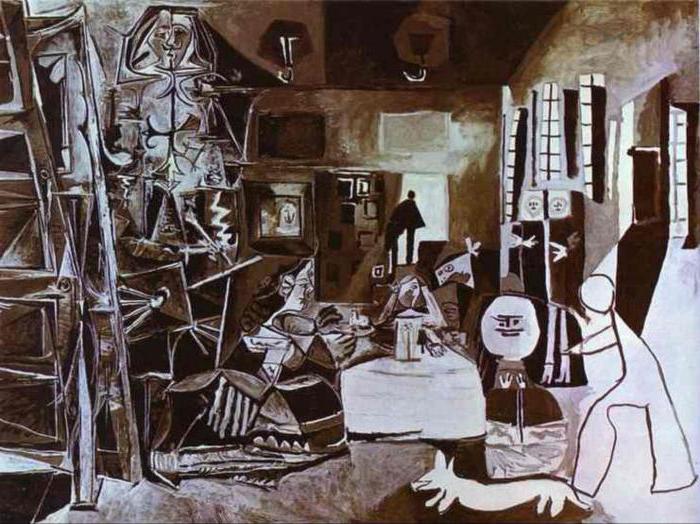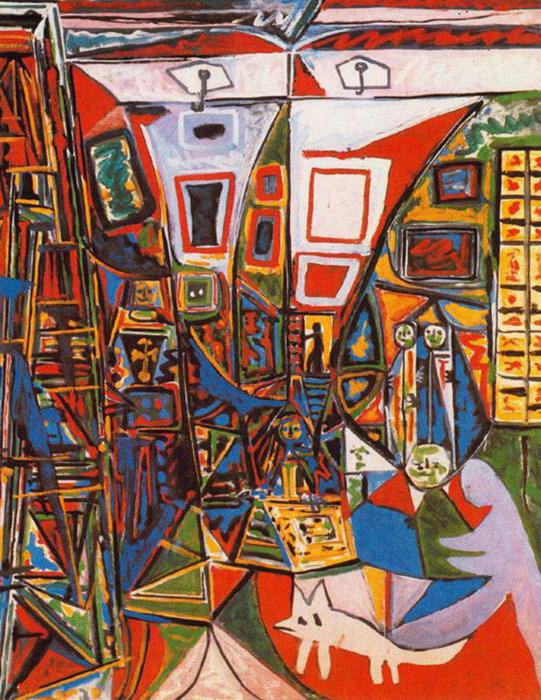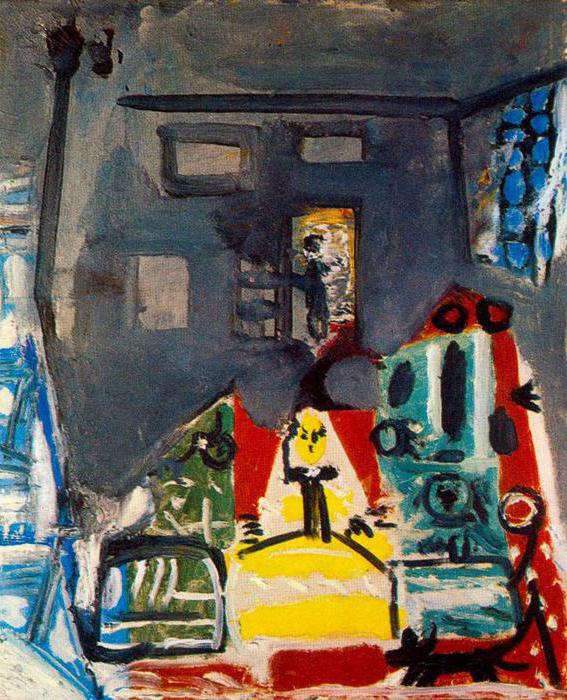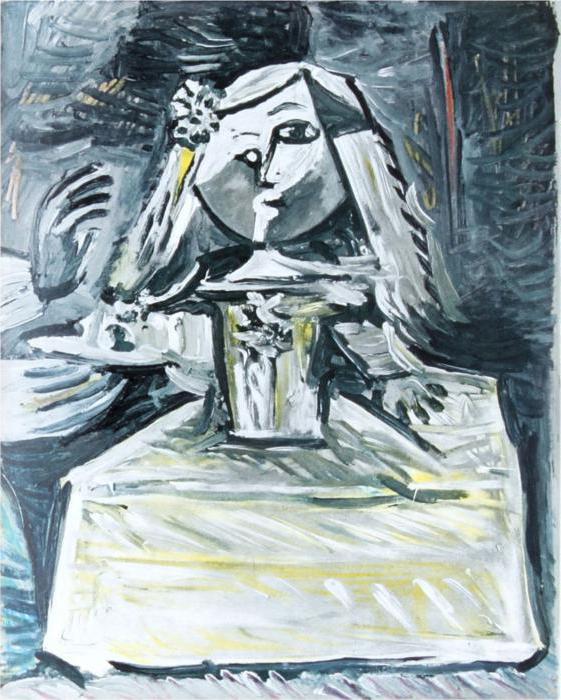Isoparafraz - the so-called painting or graphic work, created based on a painting by another artist. The deeper the content of the source material, the more interesting the approach of a master who wants to take a fresh look at recognized masterpieces, the higher the significance of such a rethinking.
Picasso’s series of Menin’s paintings, based on Velasquez’s greatest creations, is the result of the interaction of two geniuses, separated in time but similar in scale to artistic talent.
Masterpiece of Velazquez
The painting, created by Diego Velazquez (1599-1660) four years before his death, requires a gradual entry and a long contemplation. It is full of riddles and subtexts that can be interpreted by every new generation of researchers and ordinary art lovers.
There are many mysterious things in it, starting with the name. The Spanish Las Meninas ("Maid of Honor") has become generally accepted, although the main figure of the picture is the five-year-old daughter of the Spanish monarch Philip IV - Infanta Margarita. A canvas of 2.76x3.18 m in size is called Velazquez's self-portrait, because the figure of the artist in front of a huge canvas, which carefully looks at the viewer, is no less significant than the little princess and her entourage.
There is also the only joint image of the monarch’s couple, solved as an obscure reflection in the mirror. Hence, there are several plot options: the court painter writes a little infant and distracted by the royal parents who came, or he is busy working on a huge full-length portrait of Philip IV and his wife Marianne, who are entertained by their only daughter.
Characters
All Menin heroes have a name and a story that have survived through time. This gives additional facets to the images created by Velazquez. Maid of honor doña Maria Sarmiento, in a low bow, delivers a vessel with a drink to a royal girl who, in a tight and massive robe, cannot move freely herself and is forced to hold her posture in accordance with strict etiquette. Another maid of honor, a nun from the retinue and the bodyguard of the Infanta are also tense. Only freak jesters behave naturally. Dwarf Maria Barbola proudly shows the royal award, and little Nicolao kicks the huge mastiff.
The painter admires the little princess, writes out in detail those who make up her retinue. Only those on whom the fate of the courtiers and his own depend, he does not deserve a close look and extra effort. The monarchy couple are vague ghosts in the looking glass, and the all-powerful court marshal of the yard is a figure frozen in the aperture, with facial features smeared with a back light.
Velazquez is a true magician of light and composition. Even contemporaries were struck by the sense of reality that distinguishes Meninas. Falling beams of light and mysterious shadow spaces complement and enrich the story that the master tells. This story has been exciting people for more than three centuries, giving rise to their own associations. Picasso's “Menins”, created during other artistic styles and spiritual values, have their special meaning.
Heritage development
Pablo Picasso (1881-1973) was 14 years old when he first got with his father in the Prado Museum of Madrid. Since then, Velazquez along with Goya, El Greco, Delacroix, Courbet, Poussin began to exert a strong influence on the formation of the artist's views on the world and on painting. During his studies at the Royal Academy of Fine Arts of San Fernando (1897-1898), he did a lot of copying the paintings of these artists, penetrating into their "anatomy", trying to uncover the secrets of their magical effect on the viewer.
The canvas of Velazquez was impressive with its amazing psychological atmosphere, the complexity of the relationship between the characters, the artist and the viewer. In the memoirs of contemporaries from different periods, there is a lot of evidence of Picasso's admiration for Velasquez's brilliant design, realism, a unique composition and the highest technical skill of the master.
In his legacy there are many sketches and sketches inspired by the painting of Velazquez. In 1957, Picasso’s associations from Menin resulted in a large series in which the canvas underwent careful analysis and analysis, which contributed to the birth of new emotions and unexpected images.
History of creation
Picasso created his “Menins” almost exactly three centuries after Velazquez. He works on this cycle from August to December 1957 in his villa in southern France. It included 58 canvases of various sizes and with varying degrees of use of the Menin motifs. Here there are large monochrome and color interpretations of the entire canvas and small works depicting the main and secondary characters. Picasso’s series “Menins” also contains completely free improvisations, without direct allusions, but still inspired by the images of Velazquez.
This work is usually attributed to the late period of Picasso. It shows the lack of shackles for thought and the courage of the artistic manner, which were the result of intense creative searches, which fascinated the master for a long time. Striking freedom and audacity, with which Picasso reinterprets the “Menin”. The style of his painting in this series is the embodiment of the spirit of experiment and reformism, which is the main content of the life of the master. At the time of work on the cycle, the artist was 76 years old, he had long achieved success and recognition among professionals and the public, although some see in his works on the themes of masters of the past a desire to overcome doubts about his significance.
Picasso, "Menin": a description
Picasso painted the picture that marked the beginning of the series on August 17, 1957. This large canvas is monochrome and looks unfinished. In the composition, which Picasso, in contrast to the original, came out horizontal, you can see all the characters. Here there is an author-artist, a little infant and her retinue, the king and queen and even a dog reflected in the mirror. But the metamorphoses to which their images and the entire space of the picture are subjected create a completely new reality.

Even a fleeting comparison of the paintings of Menin by Velazquez and Picasso reveals a different approach to solving lighting and stage depth as an expressive means. Unlike the original source, which impressed the viewer with the reliability of light and shadow, the ratio of the clearly visible foreground and the muted shaded spaces of a huge atelier does not matter for the new interpretation. But even with flooded side lighting, a blinding stream remains in the opening behind the marshal’s back, emphasized by the courtier’s laconic shape. The drama emitted by this “black man” is just a small part of the emotions that the canvas generates.
An attentive and open to perception viewer will see how Picasso complements and changes the original content. Picasso's “Meninas” showcase a new filling of recognizable images. The figure of the artist grows into a gigantic construction, forming an almost architectural structure with a canvas. The cross on Velazquez’s chest is hypertrophied, according to legend, written by the king himself after the artist’s death. The maids of honor gain stiffness, similar to aggression. Dwarfs and a dog are like cartoons, but their comic does not have the easy character of pure humor.
Comparison of Fine Arts
Too differently visually interpreted "Menin" Picasso and Velazquez. Comparison of pictorial methods clearly indicates a three-century time difference. At Picasso, the main visual means is the geometrization and generalization of form. The scene becomes like reflection in broken glass fragments. Energy is born from the interaction of lines and planes, and realistic images are replaced by symbols and masks.

This becomes clearer when a multi-color canvas replaces a monochrome composition. Color enriches the story that Picasso endows with the character. In one embodiment, the yellow color in the figure of the infant gives it an unearthly glow that opposes an aggressive environment. In another, the child’s face turns into a lifeless white triangle, a symbol of the death of any human feelings in an environment that lives by strict rituals. Picasso’s painting, like the original source, is distinguished by purely figurative finds, but it is their semantic content that makes it possible to objectively compare the paintings. Velazquez and Picasso “Menins” are interpreted as a complex scene, full of almost literary content.
Another philosophy
Velazquez’s virtuoso realism and Picasso’s language of plastic symbols serve one purpose - to reflect the views of the world that correspond to their modern era. Therefore, it is difficult to detect semantic unity when comparing paintings. The "Menins" of Velazquez and Picasso refer to worlds, often opposite. The issue of the artist’s opposition to the power of rituals and class differences, relevant for the 17th century, is transformed in the 20th century into the problem of the role of art in the modern world.

In his work, Picasso solves both global and particular problems. From a new perspective, the artist evaluates the family scene, which has a light pastorality in the original source. The duality of human nature, justified by philosophers of the early XX century, is clearly expressed by Picasso. His maids of honor may contain motives of anger and aggression, the marshal appears either an ominous black silhouette, or a symbol of Christian suffering. Even a dog in one case radiates comic immediacy, in another it becomes a terrible wolf-like monster.
But this is only part of the philosophical aspects that are analyzed by the masters. The variety of problems that the viewer solves for himself is the main quality that the picture of Menin Velasquez and Picasso possesses. This is a common property of the whole work of two Spanish geniuses.
Freedom of association
Nevertheless, the difference in the approach to solving the creative tasks of Picasso and Velazquez is very large. The category of the unconscious in art, which is implicit in the regulated way of life of the 17th century and which underlies the search for leaders of new pictorial movements of the twentieth century, becomes decisive here. The painting “Meninas” by Velazquez and Picasso especially emphasizes this. Based on the findings of the genius of the past, the leading avant-garde artist of the 20th century creates a world built on matters that are too dependent on his subconscious. It is difficult to believe in the awareness of each movement of the Picasso brush and the absolute thoughtfulness of any element of the canvas. In relation to Velazquez, this approach is more obvious.

Clinging to any, the most insignificant initial element, Picasso comes to an amazing result. Having seen on the original a thin vertical line behind the dwarf Nicolasito and paying attention to the unusual position of his fingers, he in one of the options creates the image of a puppet playing the harpsichord.
The freedom of association and the limitless imagination are especially striking when you compare the paintings. Velazquez and Picasso “Menins” are filled with many allusions and references, and the choice of this masterpiece as a push for inspiration is absolutely not accidental. The connection of the two canvases through the centuries is obvious. Riddles contained in a 17th-century masterpiece are solved in their own way by the canvas of the great avant-garde artist. At the same time, many of the problems that Picasso poses for the viewer are timeless.
Menin, Picasso and Velazquez: Comparison
What are the main differences between the two masterpieces?
- These paintings belong to various artistic styles. Velazquez - master of baroque, Picasso - leader of avant-garde art
- The original image is striking in realism, the characters of Picasso are arbitrary.
- The main canvas of the Picasso series was created in monochrome, Velazquez used a rich color palette.
They have one thing in common:
- Picasso's abstract replica, like the original source, has a certain plot and story of the characters' relationships.
- The variety of problems raised, the main of which is the role of the artist and art in the world and society.